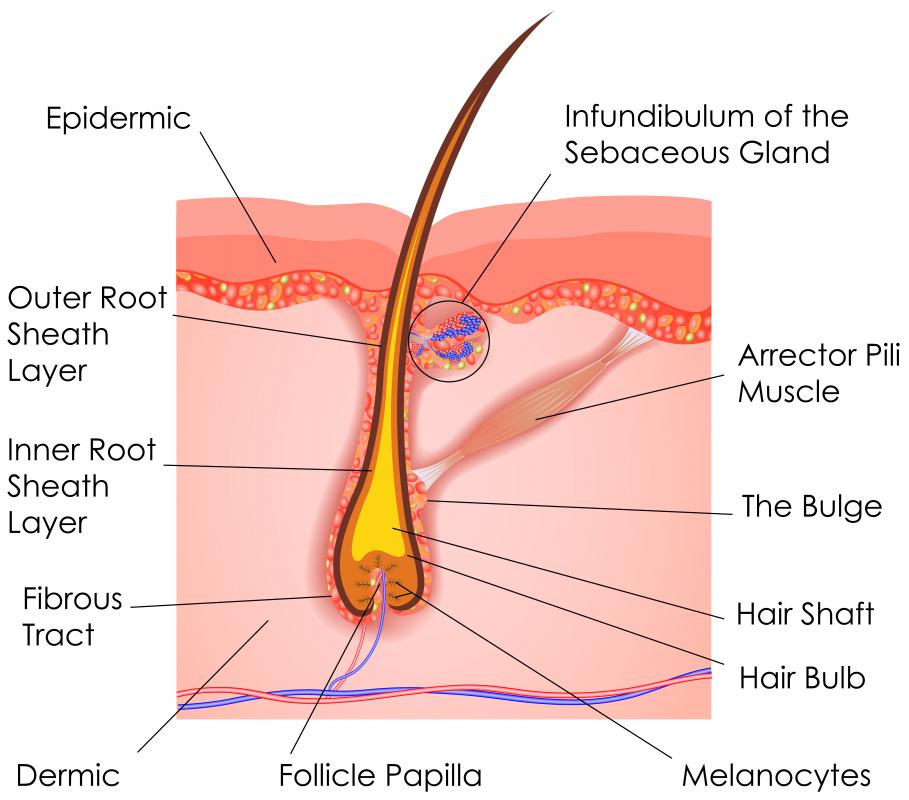At BeautyAnswered, we're committed to delivering accurate, trustworthy information. Our expert-authored content is rigorously fact-checked and sourced from credible authorities. Discover how we uphold the highest standards in providing you with reliable knowledge.
What are Hair Growth Patterns?
Human hair grows in particular directions, in particular areas and to particular lengths. These identifiable features are known as hair growth patterns. These patterns are generally controlled by genetics and hormones. Hair growth patterns include cowlicks, hairline heights, widow's peaks and male pattern baldness. Hairdressers try to cut hair to suit a person's specific pattern of growth.
Head hair begins growing at a certain, genetically predetermined hairline on the forehead. As men age, some of them will see their hairline recede. While there is such a thing as female pattern baldness, most women do not suffer from a receding hairline; hair can become thinner as women age, though, making the hairline appear to recede. Male pattern baldness occurs when the hairline receding from the forehead is joined by a bald patch at the back of the head. This condition, also genetic, is affected by the hormone testosterone.

Some people have widow's peaks on their hairline. A widow's peak is a pointed section of hair at the middle of the hairline that is farther forward than the hairline to the sides. Widow's peaks can be covered by cutting the hair so the uneven hairline is concealed.
A cowlick is an area of hair on the forehead, crown, or nape of the neck that grows in different directions. This causes the clump of hair to stick up from the rest of the hair. Cowlicks can be controlled by leaving that section of hair long enough that weight forces the hair to flatten down instead of sticking up. If a shorter cut is desired, it may be best to cut the cowlick shorter than the rest of the hair, so the cowlick blends in better.

Crown hair growth patterns usually are seen at the back of the head and involve areas where the hair grows in a spiral shape, leaving some scalp that is not covered by the hair shafts like the rest of the hair. Some people have a double crown, meaning there are two points on the back of the head where the hair grows in opposite directions. Crown hair generally grows in a clockwise direction.

A whorl is an area of hair that grows in a circular direction. This most often occurs at the back of the head. Whorls and crowns leave areas of scalp more exposed than other areas of the head, so hairdressers also cut these areas of hair to a length that allows the hair to lie flat and cover the exposed patch.
The rest of the human body also exhibits hair growth patterns. A baby in the womb goes through a phase of being covered with soft hair, which he loses about two months before birth. At puberty, hormonal changes cause thick, coarse hair to appear in the pubic area and under the arms. Body hair grows to a much shorter length than head hair.
AS FEATURED ON:
AS FEATURED ON:















Discussion Comments
@MrsPramm - It's not a modern thing at all though. Men and women have been using hair growth products and dreaming up methods to remove their hair for thousands of years.
If anything we are more accepting now than we probably used to be. I don't know anyone who doesn't think a bald head can be sexy if it is worn with confidence.
@pleonasm - Even if you don't want to show it to the world there's no need to feel bad about it. Lots of women have more hair than they think they should. And then there are women who end up losing the hair on their heads and are scrambling to find hair loss prevention products that will work for them.
Hair is one of those things that I wish we had either an awesome product that would magically make it grow or go away as we want it to, or that we simply didn't worry about it so much. I can never believe how much money people will spend on waxing and styling so that they have just the right amount of hair on their bodies and no more.
If you try to view it from an outsider's perspective it does seem kind of ridiculous.
If you've got a hormonal disorder, like I do, you might be a woman but you'll have male hair growth patterns which can be really embarrassing. It's hard to remember sometimes that it's natural hair growth when it seems like something you are always struggling to control.
Apparently it's just something you have to live with. I've even tried permanent hair removal and it's never worked, because the hormones just make it grow back.
Post your comments